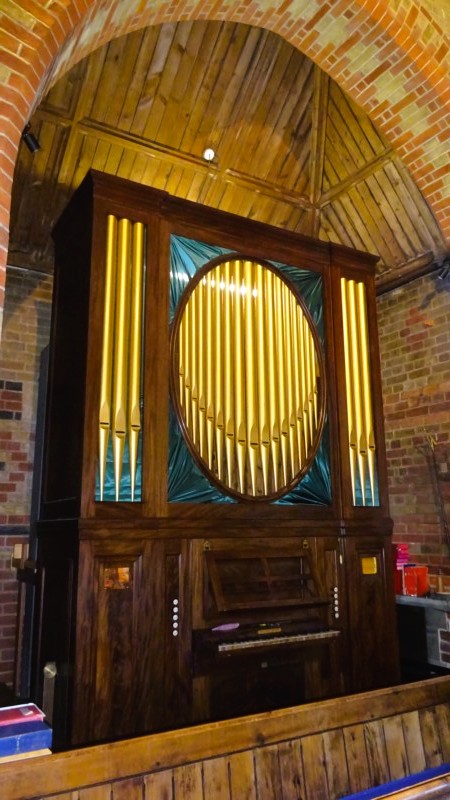


The organ comprises of the following:-
Drawstop Mechanism currently all pulling to the right:-
| Open Diapason | Flute | Fifteenth |
| Stopped Diapason bass | Principal bass | Sesquialtera bass |
| Stopped Diapason treble | Principal treble | Sesquialtera bass treble |
| Dulciana |
Pipes: Green used e high tin content in his metal pipes, and the wooden pipes are of pine with oak caps.
Mechanical key action
Soundboard
Bellowswork
Manual Keys: These were originally on a drawer, which could be closed when not in use.
Pedalboard: A curved pedal board has been fitted, but originally it would not have had a pedal board.
Console
Casework: Largely original, with flame mahogany front panel.
Display Pipes: There are 23 dummy display pipes, which have been painted gold, but would originally have been water gilded.
Blowing Plant
The church of St. John the Evangelist was built between May 1823 and May 1825 as a Chapel of Ease attached to the Parish Church of St. Mary's, Princes Risborough. The polygonal chancel was added in 1871. It was designed by the architect responsible for the Vicarage, and is said to have been commissioned by the vicar at the time.
The Samuel Green organ was previously in the Vicarage. Rumour has it that before that time it was in Hampden House, but this has not been verified. During the incumbency of the Rev. William Burgess, who served at Lacey Green from 1848 to 1880, and to whom the East window is dedicated, the church acquired the Samuel Green Organ. Records tell us that it was presented by Miss Burgess, who had owned it, and played it in the Vicarage (now Lacey House) drawing room.
In 1861, it is recorded as having been located in the West Gallery (now the Upper Room), where we believe it was played by the donor. It was later moved and placed further forward than it is today. There was then only one row of choir pews in front of it, and the choir vestry was behind. The fireplace of this small room can still be seen to the right of the organ in its present position in the alcove on the north side of the chancel. Boys from the village used to manually pump it when the organist, Miss Nancy Hawes, who was also a teacher at the local Church of England School, waved her handkerchief. One of her pupils, Harold Williams, became organist after her, and continued playing for many years.
The organ is a 1792 example of the work of the well know 18th century organ builder, Samuel Green, who was also responsible for the 1783 organ in High Wycombe Parish Church, and the 1790 organ in the Chapel Royal, Windsor. The instrument is a "drawer" chamber organ intended originally for a drawing room. It is in largely original condition, and is considered to be historically important.
An, electric blower was added in 1937. In 1951, the organ was subject to_ alterations, some of which are now considered regrettable.
The work was 'carried out by Kingsgate Davidson. The Dulciana 8' stop was removed from the main chest and placed in a small second hand swell box on electric action, with an octave extension, so as to increase the versatility and range of the instrument. At the same time, a pedal board, a coupler, a second hand Gamba 8' and 16' bourdon pipe were added. It is probable that it was also at that time that the metal pipes (previously cone tuned), were cut down, and fitted with tuning slides. A kick down swell pedal was added to the right of the pedal board.
The current pitch of the organ is flat to modern standard by half a semi-tone, i.e. A = 425.4. Green's pitch was generally slightly flatter at about A = 423.
A brass plaque on the organ testifies that this work was done in memory of Harold Edward Carter, who once owned Grymsdyke (the "big house") in, Lacey Green.
in 1992, the bicentenary of the organ was celebrated with a dramatic and musical pageant, performed by the choir and members of the congregation, and written by the incumbent's wife, Mrs Elizabeth Hale. A major fund raising effort is currently underway to restore the organ to its former glory, and it is proposed to perform this pageant again to celebrate completion of the work.
What is known of Samuel Green's life comes from the writings of the Rev. Andrew Freeman in the 1940s.
Samuel was born in 1740. it seems likely that he was apprenticed to the younger Byfield, who took him into partnership about 1769. Byfield probably retired in 1772, Green then went into business for himself, in Red Lion Street in Holborn. He later moved to lslington.
His first success was at St. Katherine's by the Tower, in London. From there, he went on to several important contracts, including Canterbury, Wells and Salisbury Cathedrals, and the Chapel Royal at Windsor.
Unfortunately, the latter organ was destroyed in the recent Fire. Organs were becoming very popular at this time. The first book of church hymns was produced, and the Wesley brothers wrote many stirring examples.
Green became the favoured organ builder of King George III, who had a great interest in organs. His organs were renowned for their sweetness of tone. His parlour organs, like the one at Lacey Green were particularly highly regarded, and were said to "fill the room with a warm silvery quality".
Green died in 1796. Apparently his business sense had not been as great as his genius in building organs. A writer said of him, "A man so eminent in his profession, at his death was not able to leave a slender provision for his family". His widow and two daughters, Sarah and Elizabeth, survived on a pension from the King.
Although in fairly original condition for its age, the organ is urgently in need of substantial restoration. The parish is keen to retain the
Instrument for the benefit of future music lovers, but unable to 'fund Such a large project. Grants are being sought from the Heritage Lottery Fund and the the Council for the Care of Churches.
As a single manual instrument with pedal board, it is ideal for training organists. It is studied by local school children, and visited by organ lovers. It is regularly used for services and to accompany concerts. It has proved extremely versatile for classical and modern music. After restoration it would be used for organ recitals and talks.
The organ is considered of great historical importance, and worthy of conservation. The parish is, therefore, hopeful of obtaining grant funding.
The parish is hoping to find funding for the following work, which respects the historicity of the instrument, whilst retaining efficiency:-Clean and repair pipework
Remake soundboard
Overhaul mechanical key action
Reinstate original drawstop mechanism
Clean and check bellowswork
Revise trunking
Return manual keys to drawer style
Fit new pedalboard
Tidy casework, and regild display pipes
Remove secondhand swell box (fitted 1951), and make good